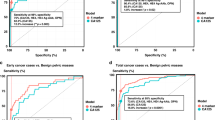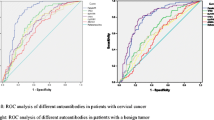Abstract
Purpose
To examine the clinical significance of an autoantibody (AAb) against a novel tumor-associated antigen (TAA) derived from human DNA-topoisomerase I, termed as TOPO48 AAb, and peripheral blood survivin-expressing circulating cells (CCC) in patients with early stage endometrial cancer (EC).
Methods
Blood samples were collected from 80 patients with early stage EC and 80 age-matched healthy subjects. Plasma levels of the TOPO48 AAb were measured with a specific antibody capture enzyme-linked immunosorbent assay (ELISA) and blood survivin-expressing CCC assessed with a reverse transcription-polymerase chain reaction products based on a hybridization-enzyme-linked immunosorbent assay (RT-PCR–ELISA). Sixty patients were followed up for 36 months after the initial assay test.
Results
There were 75% and 60% samples with positive levels of the TOPO48 AAb and survivin-expressing CCC in the cancer patients, respectively. However, the cumulative positive rate of combination of the two markers was increased to 93.3% with 0.927 (95% CI 0.871–0.984) of area under the curve (AUC) in receiver operating characteristic (ROC) curve analysis. During the follow-up period, patients with positive TOPO48 AAb but negative surviving-expressing CCC had a higher survival rate and a longer survival time than those with negative AAb but positive CCC (P = 0.01).
Conclusions
The combination of TOPO48 AAb and survivin-expressing CCC may be used as a novel recipe to improve the efficiency of early diagnosis and provide more accurate prognostic prediction in patients with early stage EC.




Similar content being viewed by others
References
McAlpine JN, Temkin SM, Mackay HJ (2016) Endometrial cancer: not your grandmother’s cancer. Cancer 122:2787–2798
Chen W, Zheng R, Baade PD, Zhang S, Zeng H, Bray F, Jemal A, Yu XQ, He J (2016) Cancer statistics in China, 2015. CA Cancer J Clin 66:115–132
Carlson MJ, Thiel KW, Leslie KK (2014) Past, present, and future of hormonal therapy in recurrent endometrial cancer. Int J Womens Health 6:429–435
Creasman WT, Odicino F, Maisonneuve P et al (2006) Carcinoma of the corpus uteri. FIGO 26th annual report on the results of treatment in gynecological Cancer. Int J Gynaecol Obstet 95(1):105–143
Reuschenbach M, von Knebel Doeberitz M, Wentzensen N (2009) A systematic review of humoral immune responses against tumor antigens. Cancer Immunol Immunother 58:1535–1544
Zaenker P, Ziman MR (2013) Serologic autoantibodies as diagnostic cancer biomarkers–a review. Cancer Epidemiol Biomarkers Prev 22:2161–2181
Tang ZM, Ling ZG, Wang CM, Wu YB, Kong JL (2017) Serum tumor-associated autoantibodies as diagnostic biomarkers for lung cancer: a systematic review and meta-analysis. PLoS One 12:e0182117
Werner S, Chen H, Tao S, Brenner H (2015) Systematic review: serum autoantibodies in the early detection of gastric cancer. Int J Cancer 136:2243–2252
Lacombe J, Mangé A, Solassol J (2014) Use of autoantibodies to detect the onset of breast cancer. J Immunol Res 2014:574981
Zhang H, Xia J, Wang K, Zhang J (2015) Serum autoantibodies in the early detection of esophageal cancer: a systematic review. Tumour Biol 36:95–109
Chen H, Werner S, Tao S, Zörnig I, Brenner H (2014) Blood autoantibodies against tumor-associated antigens as biomarkers in early detection of colorectal cancer. Cancer Lett 346:178–187
Yie SM, Ye SR, Ma XL, Xie K, Zhang JB, Cao M, He X, Hu ZB, Yang CL, Zhang J, Zhen J (2016) A protein fragment derived from DNA-topoisomerase I as a novel tumor associated antigen for the detection of early stage carcinoma. Br J Cancer 115:1555–1564
Zhang JB, Cao M, Chen J, Ye SR, Xie K, He X, Ma XL, Zhang J, Yie SM (2018) Serum anti-TOPO48 autoantibody as a biomarker for early diagnosis and prognosis in patients with esophageal squamous cell carcinoma. Clin Res Hepatol Gastroenterol 42:276–284
Wu WB, Yie SM, Ye SR, Xie K, Zhang JB, Cao M, Chen J, He X, Ma XL, Zhang J (2018) An autoantibody against human DNA-topoisomerase I is a novel biomarker for non-small cell lung cancer. Ann Thorac Surg 105:1664–1670
Zhou L, Dicker DT, Matthew E, El-Deiry WS, Alpaugh RK (2017) Circulating tumor cells silent predictors of metastasis. Research 14:6
Lianidou ES, Markou A (2011) Circulating tumor cells in breast cancer: detection systems, molecular characterization, and future challenges. Clin Chem 57:1242–1255
Bogani G, Liu MC, Dowdy SC, Cliby WA, Kerr SE, Kalli KR, Kipp BR, Halling KC, Campion MB, Mariani A (2015) Detection of circulating tumor cells in high-risk endometrial cancer. Anticancer Res 35:683–687
Ni T, Sun X, Shan B, Wang J, Liu Y, Gu SL, Wang YD (2016) Detection of circulating tumour cells may add value in endometrial cancer management. Eur J Obstet Gynecol Reprod Biol 207:1–4
Yie SM, Luo B, Ye NY, Xie K, Ye SR (2006) Detection of survivin-expressing circulating cancer cells in the peripheral blood of breast cancer patients by a RT-PCR ELISA. Clin Exp Metastasis 23:279–289
Yie SM, Lou B, Ye SR, Cao M, He X, Li P, Hu K, Rao L, Wu SM, Xiao HB, Gao E (2008) Detection of survivin-expressing circulating cancer cells (CCCs) in peripheral blood of patients with gastric and colorectal cancer reveals high risks of relapse. Ann Surg Oncol 15:3073–3082
Yie SM, Lou B, Ye SR, He X, Cao M, Xie K, Ye NY, Lin R, Wu SM, Xiao HB, Gao E (2009) Clinical significance of detecting survivin-expressing circulating cancer cells in patients with non-small cell lung cancer. Lung Cancer 63:284–290
Cao M, Yie SM, Wu SM, Chen S, Lou B, He X, Ye SR, Xie K, Rao L, Gao E, Ye NY (2009) Detection of survivin-expressing circulating cancer cells in the peripheral blood of patients with esophageal squamous cell carcinoma and its clinical significance. Clin Exp Metastasis 26:751–758
Gradilone A, Petracca A, Nicolazzo C, Gianni W, Cortesi E, Naso G, Vincenzi B, Cristini C, De Berardinis E, Di Silverio F, Aglianò AM, Gazzaniga P (2010) Prognostic significance of survivin-expressing circulating tumour cells in T1G3 bladder cancer. BJU Int. 106:710–715
Ning Y, Hanna DL, Zhang W, Mendez A, Yang D, El-Khoueiry R, Matsusaka S, Sunakawa Y, Stremitzer S, Parekh A, Okazaki S, Berger MD, Barzi A, Lenz HJ (2015) Cytokeratin-20 and Survivin-Expressing Circulating Tumor Cells Predict Survival in Metastatic Colorectal Cancer Patients by a Combined Immunomagnetic qRT-PCR Approach. Mol Cancer Ther 14:2401–2408
Cao W, Yang W, Li H, Lou G, Jiang J, Geng M, Xi W, Ren R, Qu Q, Jin X, Zhu Y, Jin Y (2011) Using detection of survivin-expressing circulating tumor cells in peripheral blood to predict tumor recurrence following curative resection of gastric cancer. J Surg Oncol 103:110–115
Steinbakk A, Malpica A, Slewa A, Skaland I, Gudlaugsson E, Janssen EA, Løvslett K, Fiane B, Kruse AJ, Feng W, Yinhua Y, Baak JP (2011) Biomarkers and microsatellite instability analysis of curettings can predict the behavior of FIGO stage I endometrial endometrioid adenocarcinoma. Mod Pathol 24:1262–1271
Ambrosini G, Adida C, Altieri D (1997) A novel anti-apoptosis gene, survivin, expressed in cancer and lymphoma. Nat Med 3:917–921
Yilmaz E, Koyuncuoglu M, Görken IB, Okyay E, Saatli B, Ulukus EC, Saygili U (2011) Expression of matrix metalloproteinase-2 and survivin in endometrioid and nonendometrioid endometrial cancers and clinicopathologic significance. J Gynecol Oncol 22:89–96
Brunner A, Riss P, Heinze G, Brustmann H (2012) pHH3 and survivin are co-expressed in high-risk endometrial cancer and are prognostic relevant. Br J Cancer 107:84–90
Sorosky JI (2008) Endometrial cancer. Obstet Gynecol 111:436–447
Wilczyński M, Danielska J, Wilczyński J (2016) An update of the classical Bokhman’s dualistic model of endometrial cancer. Prz Menopauzalny. 15:63–68
Suh DH, Kim JW, Kang S, Kim HJ, Lee KH (2014) Major clinical research advances in gynecologic cancer in 2013. J Gynecol Oncol 25:236–248
Funding
This study was partially supported by Grant no. KJXM20030826 from the Research and Development Program of the Chengdu Technology Bureau, Chengdu, China, and partly supported by Sichuan Science and Technology Program (Grant no. 2018SZ0144,2016SZ0066, 2018SZ0284 and 2018FZ0043) and West China Second University Hospital of Sichuan University (Grant no. kx027).
Author information
Authors and Affiliations
Contributions
XHJ, ZYY and XH: data collection, experimental performs, data analysis, manuscript draft writing; KX and JZ: clinical patients and control support; JBZ, JC and MC: experimental support; SMY, project development, data collection, manuscript writing and review
Corresponding author
Ethics declarations
Conflict of interest
The authors declare that they have no conflict of interest.
Ethical approval
All procedures performed in this study involving were in accordance with the ethical standards of the institutional research committee of the Sichuan Provincial People’s Hospital (No. 20070126,) and with the 1964 Helsinki declaration and its later amendments or comparable ethical standards.
Informed consent
Informed consent was obtained from all individual participants included in the study.
Availability of data and materials
We have full control of all primary data and that we agree to allow the Journal to review our data if requested.
Rights and permissions
About this article
Cite this article
Jiang, Xh., Yao, Zy., He, X. et al. Clinical significance of plasma anti-TOPO48 autoantibody and blood survivin-expressing circulating cancer cells in patients with early stage endometrial carcinoma. Arch Gynecol Obstet 299, 229–237 (2019). https://doi.org/10.1007/s00404-018-4938-7
Received:
Accepted:
Published:
Issue Date:
DOI: https://doi.org/10.1007/s00404-018-4938-7




